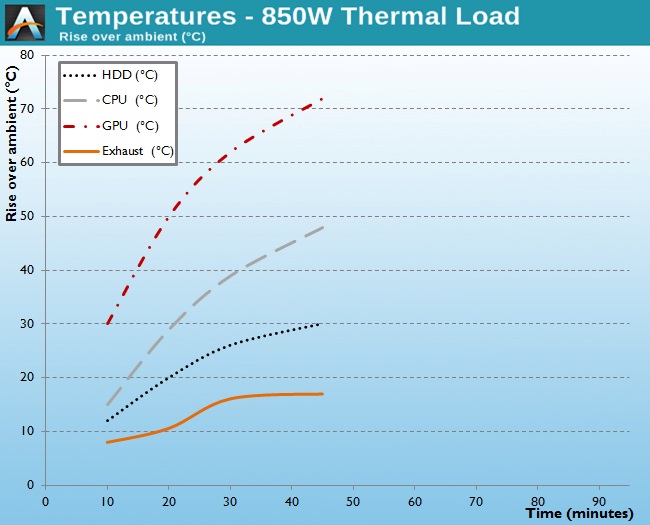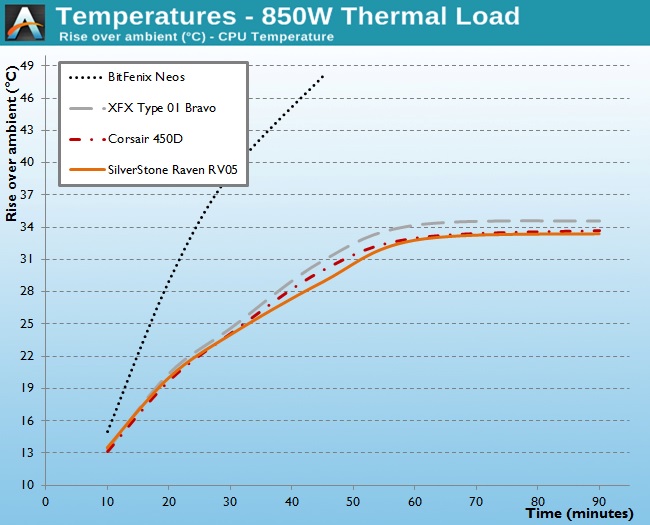BitFenix Neos Case Review
by E. Fylladitakis on January 21, 2015 9:00 AM EST- Posted in
- Cases/Cooling/PSUs
- bitfenix
- Case
Test Setup
Professional testing requires the emulation of real-world situations with repeatable results; thus, a perfectly controllable test setup and environment are required, especially for comparable results. Testing the thermal performance of any case with a typical real-world setup technically limits the comparability of the results to this setup alone, as an active system interacts with its environment and the change of a single component would alter myriads of variables.
To help alleviate such issues, we developed synthetic loads that emulate the thermal output of real systems, but these loads are passive, steady, and quantifiable. Our thermal testing now displays the thermal capabilities of the case alone, as if it would have to deal with the entire thermal load by itself, regardless of the system installed inside it. Laboratory data loggers are used to monitor the PT100 sensors and control the safety relays, which are fully accessible via our custom software.
Three such loads have been developed; the ATX version simulates a 200W CPU, 50W VRM, 30W RAM and 4 × 120W GPU card thermal load. Finally, three 3.5" HDD dummy loads have also been created, with each of them converting 30W of electrical power to thermal, bringing the total thermal load of the ATX test setup up to 850 Watts. This thermal load is immense and only the best of cases will be able to handle it for more than a few minutes; we are also performing a test with a thermal load of 400W, with all of the aforementioned components except the HDD drives at about 42% power, which is more suitable for the majority of cases.
Thermal testing is performed with the stock fan operating at maximum speed. Noise testing is performed with a background noise level of 30.4dB(A). Advanced noise testing is also performed, in order to assess the ability of the case to dampen the noise of the components installed inside it. This includes the installation of two noise-generating sources (strong fans) inside the case, one positioned approximately over the first expansion slot and one over the CPU area, which generate ≈ 44.2 dB(A) when unobstructed. During the advanced noise test, all stock cooling options of the case are entirely disabled.
Results and Discussion
Our testing ended prematurely when the thermal load was operating at full power, as the thermal failsafe kicked in. Sadly, the stock thermal performance of the Neos is, simply put, horrific. Despite the large openings at the front of the case and the presence of a strong 120mm exhaust fan, the Neos performed far worse than we originally anticipated. It handles the 400W load better, but it's definitely not the best case for high performance systems.
When compared to other cases of similar size, the enormous difference becomes apparent. Note that the thermal load used during our testing is immense; a typical home/gaming system with a single GPU should operate just fine in the Neos, yet the operating temperatures will be considerably higher than with a more advanced case.
There is just one 120mm cooling fan in the Neos, and it is a fairly strong and noisy model. The single 120mm fan generates 44.3dB(A), which is enough to be clearly audible to the user from one meter away. There are no fan control options for the Neos, therefore a fan controller is required to achieve the 50% and 70% fan speeds depicted in the chart below.
As expected, the Neos has very little noise reduction capabilities as well. It is simply not designed with low-noise operation in mind and there are virtually zero noise reduction measures about this case. The many openings at the front do not help either. The Neos reduced the noise level of our artificial noise source from 44.2dB(A) to 43.0dB(A), a very small and virtually imperceptible difference for the human ear.















54 Comments
View All Comments
maecenas - Wednesday, January 21, 2015 - link
Wow, probably the most searing Anandtech review I've seen. Thank you for your honesty, I'll steer clear of this product....nathanddrews - Wednesday, January 21, 2015 - link
The first thing I thought was "are you sure your components are operating properly?" The results are outstanding, for sure. My personal experience with cases has been to either buy the most basic, affordable POS with its own PSU or go big and spend extra to get something really nice. There's not much in between.sfuzzz - Wednesday, January 21, 2015 - link
Well, it's not completely true. For example, The CM N200 is a good microATX case (decent aestetics too, however it's subjective) that costs half the case in this review and can handle pretty powerful systems on air and liquid.drainplugofideas - Wednesday, January 21, 2015 - link
I have that case! I really like it overall.Samus - Wednesday, January 21, 2015 - link
I tried a Bitfenix Prodigy ITX about a year ago, and the case was simply awful. It weighed a ton, the panels were unnecessarily heavy, which directly correlated to poor thermals. It was like an oven inside, even with a 200mm intake and 120mm exhaust fan. The memory modules were too hot to touch. The 200mm fan was useless...even after replacing it with a coolermaster fan, it was apparent the problem was the air holes for the fan. There were 6 of them, and they are dime-sized. The intake system was starved. The appearance of these cases leads you to believe they are well designed, when in fact they are just a crap covered in glitter. The icing on the cake is the price. They are twice as expensive as competing models from Coolermaster, Antec, and Corsair, companies vastly more experienced in case manufacturing and design.Stay away from Bitfenix. If you're going to spend this level of money on something, get a "real" case from Lian Li, Silverstone, or a high end product from another established manufacture.
Gigaplex - Wednesday, January 21, 2015 - link
"I tried a Bitfenix Prodigy ITX about a year ago, and the case was simply awful. It weighed a ton, the panels were unnecessarily heavy"I have a Prodigy, and I agree, it's heavy for its size.
"which directly correlated to poor thermals"
It sounds like you got a model with the solid faceplate. The mesh faceplate models give excellent thermal performance, and I have no issues with mine. Even the AnandTech review of it gave it an Editors Choice award. The fact that the panels are heavy don't contribute to poor thermal performance.
Alexvrb - Thursday, January 22, 2015 - link
While not as good at conducting heat as aluminum, steel isn't really an insulator so I doubt having a little thicker panels is going to trash cooling performance. I've used some really stout cases, including oldschool Lian Li cases that were built out of what seemed like 1/4" thick steel. They worked great even though they had panels that were "unnecessarily heavy". Airflow is much more important and it sounds like the particular model you bought suffered from poor airflow. Based on what I've seen and heard it would Bitfenix has at least some good models out there. Also Coolermaster makes a variety of fans and depending on the model it may not push significantly more air especially in a restrictive case (perhaps due to poor static pressure - if they don't publish this number it probably isn't very good).SleepModezZ - Wednesday, January 21, 2015 - link
Currently on Amazon the N200 is around $50 - as is the cheapest Neos. So not half the price. In Finland where I shop the N200 will cost a bit more than the Neos. Seems like a nice case and better for a gaming system but it is for a microATX board unlike the Neos that takes a full size ATX board. The Neos also has place for two 5.25 drives and not just one. (I don't think that many needs two optical drives but the 5.25 place could be used for something else. I usually have my 3.5 HDDs put into the 5.25 places to eliminate the amplification of vibration and seek noises by the case.)Samus - Wednesday, January 21, 2015 - link
There is no debate about it. Bitfenix makes crap. Anybody who says otherwise either hasn't touched one of their piece of crap products, or unfortunately owns one and is in the deeper stages of denial but will eventually reach acceptance that they do in fact own a piece of crap.There are various Corsair and Coolermaster cases that may not be that much cheaper ($30-$40 such as the Elite 110, Elite 361 and the Corsair Carbide Spec-01) and not much of a looker, but are significantly better at actual cooling.
I've had Rosewill cases that cost $20 and actually work, in that they house and cool components properly. Bitfenix is basically picking up old SECC tooling equipment on the cheap, hiring flunkie engineers to design what looks good, and selling them for bottom-dollar prices based on looks, not functionality or performance.
hughlle - Wednesday, January 21, 2015 - link
Unfortunately your opinion is completely and utterly contradicted by almost every review on the internet. So clearly there is a debate about it.